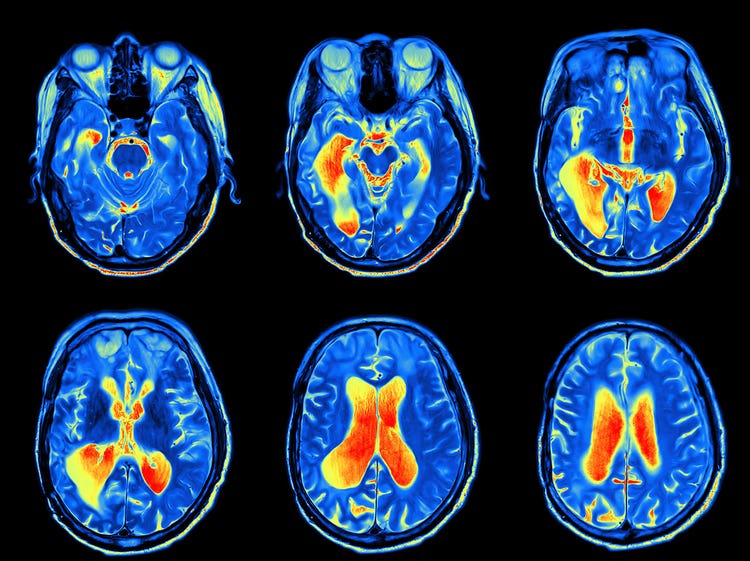The Brain’s Creative Chaos

Say goodbye to left brain, right brain thinking. The secret to creativity’s neuroscience is deeper than that.
We all have those aha moments, when an idea pops into our heads that solves a problem or creates something. Musicians, artists and writers are seen as creative individuals, but so are scientists, accountants and lawyers. Creativity isn’t just an artistic expression but the beauty of finding solutions for numerous types of issues.
People who study creativity see it as consisting of two major kinds of thinking. “One would be divergent thinking, the other would be convergent thinking,” says Dr. Adam Green, an associate professor in psychology and the interdisciplinary program in neuroscience as well as the director of the Laboratory for Relational Cognition at Georgetown University. “Divergent thinking is coming up with some really new notion that nobody ever thought of before. Convergent creativity has more to do with solving a problem, coming up with the right answer.”
Green is a founding member of the Society for the Neuroscience of Creativity, an organization of creativity researchers dedicated to elucidating the origins of creativity in the human brain. He says that one of the things that his colleagues have started to agree on is that the most effective creativity actually involves both divergent and convergent thinking. “So it’s being able to come up with lots of new possibilities and then being able to decide which one of those is actually best—divergent at first and then converging on the right answer,” Dr. Green explains. “One of the metaphors we sometimes use is to have a big menu to read from and a discerning palate to make the right choice.”
Our brain on creativity

To think of the creative process as it happens in the brain is to imagine a child’s finger-painting masterpiece—colors running together, different strokes colliding on the page, paint everywhere.
Our brains approach the creative process in more of this unstructured way. To translate this into scientific terms, think of it as a mess of neurological pathways bouncing around from brain region to brain region, almost like those airline-route maps in the back of in-flight magazines. This organized chaos is nothing like the linear idea that all our creative thinking occurs on one side of the brain. You know, the idea of left or right brain thinkers. In the last five years, neuroscience has made a case that our brains don’t pick sides.
Instead, there might be three different networks—executive attention, imagination or default, and salience—utilizing both sides of the brain during creative thinking.
The executive attention network is used during tasks that require laser focus and attention, such as problem solving and reasoning. When we are doing these things, the outer lateral regions of the prefrontal cortex and areas in the back part of the parietal lobe are utilized.
Then there is the imagination or default network that is employed when we remember past experiences or think about the future—imagining alternative perspectives or scenarios to the present—and engage in social cognition. All this happens deep inside the prefrontal cortex and temporal lobe, and these areas communicate with various outer and inner regions of the parietal cortex.
The final network that creativity may use is the salience network, which monitors external events and the internal stream of consciousness. It then sends that information to the area of the brain that can solve the task at hand.
Researchers have theories about how creative thinking is mapped in the brain. One scientific paper on the subject, published in the July 2013 issue of the journal “Frontiers in Human Neuroscience,” lends a theory to the idea of what the real neuroscience might be. It purports that the creative process appears to involve the interplay of these networks together. At different stages of the creative process, there are different patterns of neural activation and deactivation. This means that the networks work together during some instances and, in other instances, hinder the process.
The inner critic is the best example of how this process can hinder creative thought. When you allow the mind to roam freely and silence your inner critic, you are decreasing activity in the executive network and increasing activity in the imagination and salience networks. But eventually the executive network comes back into the fold to evaluate the created idea and implement it.
Fostering our creativity

Creativity is a mix of skills, knowledge, attitudes, motivations and personality traits that are intertwined with these networks. And this may explain why people who tend to be open to new experiences might be more able to produce more-creative and -original things.
“Creativity isn’t this other sort of magical thing that’s made of its own material that’s unique to creativity. It’s made of all the same things that other kinds of thinking are made of in the brain,” Green says. “As with every other kind of thinking, the more you practice it, the better you’re going to be at it.”
One of the things that Green’s data has shown is that as people get used to being creative, they get more and more creative as they build up that muscle, so to speak.
“That’s not to say that everybody has the same creative potential,” he notes. “If I train my whole life, I’ll never be as fast as Usain Bolt if he never trained at all. But if he trains, he’ll get better than he was before he trained. I think you can get better, but there are both individual differences, which is to say that some people are more creative than others, and within-person differences, which is to say that the more you work on it and the more you build that muscle, the more creative you can be.”
One of those differences might be our IQ. It might be linked to creativity in the sense that IQ tests measure the sorts of tools that can help implement creativity. However, it seems that IQ can help you only to a point. One of the suppositions that researchers are trying to get their heads around is called the threshold hypothesis. This is the notion that those kinds of tools that help with IQ can get you only to a certain point, and then it’s just a question of how creatively you can use them. Green explains it with this example: You can buy a fancier set of paints or more-expensive tools, and to a certain extent, they will help you; but at a certain point, it’s just a question of your ability to use those tools.
You can think of IQ as the tools you were born with, and while you could work to make those tools work better for you, IQ is highly heritable and stays stable over the course of your life. However, you can do certain things to help foster creativity.
“Doing creative things and being in contexts where creativity is encouraged will help you build up your creative capacity,” Green asserts. “Some of it is not being afraid of divergence. Some of it is becoming more expert in choosing from the menu once you diverge, once you have a big menu, getting better, becoming more of an expert at figuring out what is going to be the right solution.”
Then there are some literal tools that are not for the faint of heart. Earlier this year, Green and his colleagues published a paper in the journal “Cerebral Cortex” that showed how neurostimulation—zapping targeted areas of the brain with safe amounts of electrical current—facilitates the neurons or the brain cells firing in that region.
“We have actually shown in a couple of studies that people are able to become more creative when we make it easier for brain cells in a certain region in the front of the brain, called the frontopolar cortex, to fire,” Green says. This is the region that has a lot of activity when people try to succeed at thinking more creatively, according to functional MRI neuroimaging. “What we found is the ability to increase activity in that region predicted how much you would succeed at becoming more creative. So we thought, ‘Well, what if we make it easier for people to increase activity in that region? Would that make them more creative?’”
Until this sci-fi option comes to a doctor’s office near you, exercise might serve as another way to enhance your creative abilities. “The brain uses a disproportionate amount of the oxygen that comes from the blood that your heart is pumping. For both cognitive performance and brain health as you get older, cardiovascular exercise is great for you and is great for thinking,” Green says. “Anything that’s good for your heart is good for your brain, and good for your brain means good for creativity.”
Photo credits: Ridofranz, Thinkstock; akesak, Thinkstock; Alliance Stock, Adobe Stock